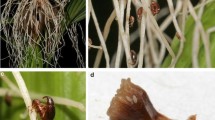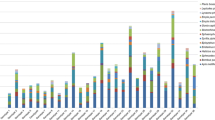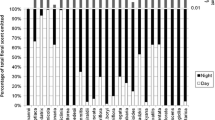Magnolia kobus
was examined at 32 sites in Japan (109 female-stage flowers from 52 plants) by GC-MS. Major chemical compounds (a total of 36 chemicals) emitted from the flowers were: linalool (and its oxides), limonene, cis- and trans-β-Ocimene, benzaldehyde, benzyl alcohol, benzyl cyanide, and 2-aminobenzaldehyde. Linalool and its oxides were the most abundant components of floral scents in 21 individuals. The rate at which chemical volatiles were emitted ranged from 0.002 to 0.929 μg/flower/hour (average 0.211). High quantitative and qualitative variation in floral scent chemistry among individuals was found throughout the range of M. kobus, especially in central Honshu. The high variability in floral scent chemistry may be due to the importance of visual cues in the reproductive biology of M. kobus which flowers in early spring, resulting in decreased selection for specific floral scent profiles. Alternatively, different scent compounds or chemical profiles may be equally effective in attracting pollinators.
Similar content being viewed by others
Author information
Authors and Affiliations
Additional information
Received 25 June 2001/ Accepted in revised form 25 August 2001
Rights and permissions
About this article
Cite this article
Azuma, H., Toyota, M. & Asakawa, Y. Intraspecific Variation of Floral Scent Chemistry in Magnolia kobus DC. (Magnoliaceae). J Plant Res 114, 411–422 (2001). https://doi.org/10.1007/PL00014006
Issue Date:
DOI: https://doi.org/10.1007/PL00014006




